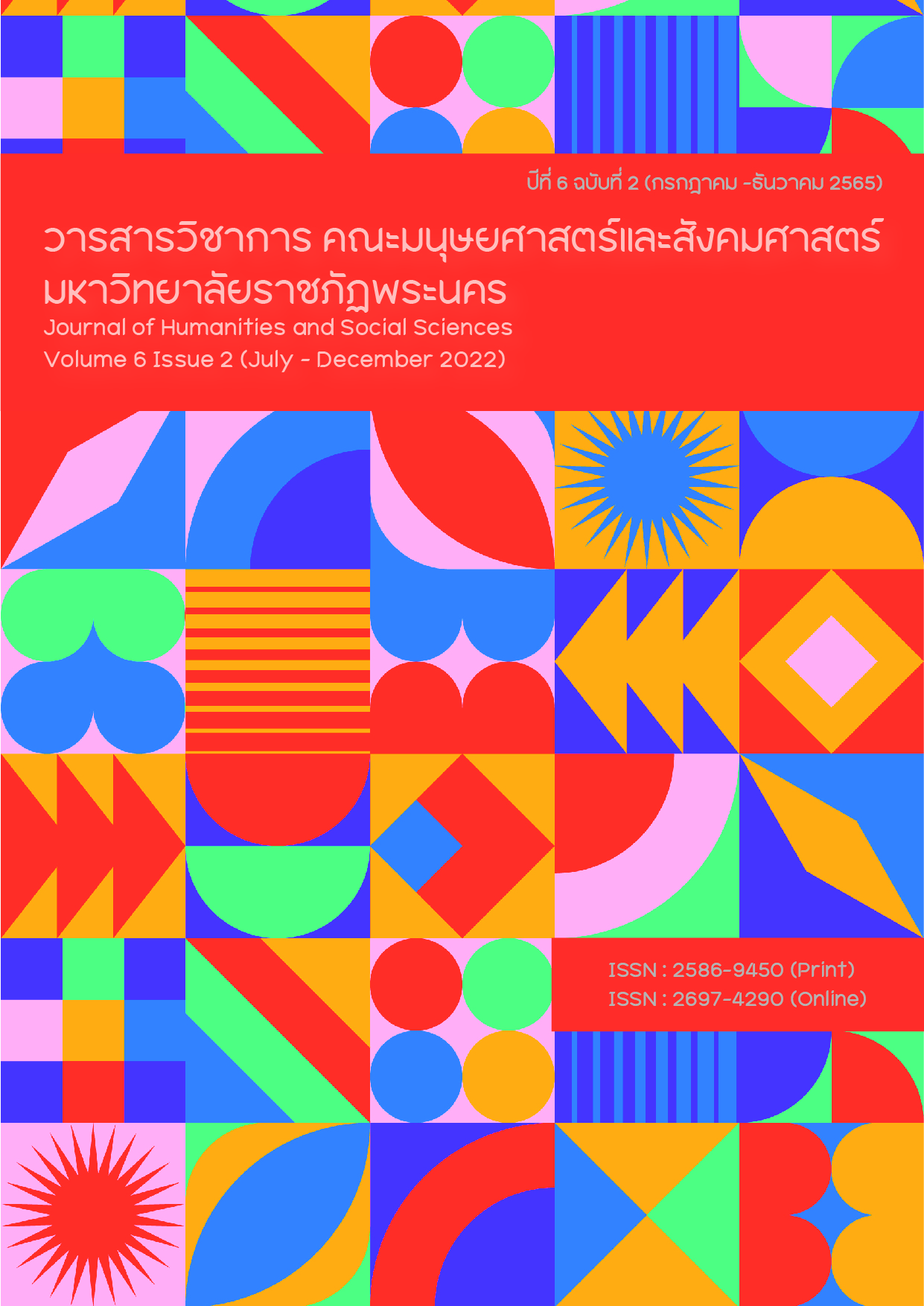กลวิธีในการรำเดี่ยวของตัวนางในละครรำ
Main Article Content
บทคัดย่อ
วิทยานิพนธ์ฉบับนี้มีวัตถุประสงค์เพื่อ1)ศึกษาบทบาทความสำคัญของการแสดงรำฉุยฉายตัวนางที่ปรากฏในการแสดงละครรำ 2) วิเคราะห์องค์ประกอบท่ารำในกระบวนการแต่งกายของการรำฉุยฉายวันทอง (แต่งตัว) 3)วิเคราะห์การรำเดี่ยวของตัวนางในการรำฉุยฉายวันทอง(แต่งตัว) ในละครเรื่องขุนช้างขุนแผน ตอนพระไวยแตกทัพ การดำเนินการวิจัยใช้กระบวนการวิจัยเชิงคุณภาพโดยการศึกษาจากเอกสารตำราวรรณกรรมและงานวิจัยที่เกี่ยวข้อง การสัมภาษณ์การสังเกต การถ่ายทอดกระบวนท่ารำและการศึกษาจากวิดิทัศน์การแสดงรำฉุยฉายวันทอง(แต่งตัว)ของอาจารย์อัจฉรา สุภาไชยกิจ
ผลการวิจัยพบว่าบทบาทความสำคัญของการรำฉุยฉายตัวนางคือการที่ตัวละครแต่งกายหรือแปลงกายได้อย่างงดงามสมใจ แล้วจึงแสดงความภาคภูมิใจและความพอใจสื่อทางกระบวนท่ารำรวมทั้งการถ่ายทอดอารมณ์ทางใบหน้าแววตา องค์ประกอบท่ารำในกระบวนการแต่งกายฉุยฉายวันทองประกอบด้วยท่ารำต้นแบบจากการรำแม่บทและท่าธรรมชาติในการแสดงอารมณ์กิริยาเพื่อสื่อความหมายตามบทร้อง ปรากฏในเพลงบทร้องทำนองเพลงชมตลาดกระบวนท่ารำสื่อถึงการบรรยายเครื่องแต่งกายเครื่องประดับและศิราภรณ์ของนางวันทอง บทร้องและทำนองเพลงฉุยฉายกระบวนท่ารำสื่อถึงการบรรยายความงามของนางวันทองที่แปลงกายเป็นหญิงสาวมีใบหน้าและรูปร่างงดงาม บทร้องและทำนองเพลงแม่ศรีกระบวนท่ารำสื่อถึงการบรรยายถึงการเดินทางของนางวันทองเพื่อไปรอรับพระไวยผู้เป็นลูก โดยปรากฏลักษณะการแสดงออกทางอารมณ์ผ่านใบหน้าและแววตา ส่วนกลวิธีในการแสดงรำฉุยฉายวันทอง(แต่งตัว)ของอาจารย์อัจฉรา สุภาไชยกิจประกอบด้วย 1)กลวิธีในการเตรียมตัวก่อนแสดง 2)กลวิธีในการถ่ายทอดอารมณ์เพื่อการแสดงที่สมจริง 3)กลวิธีในการรำเพื่อแสดงให้เห็นถึงความรู้ความสามารถของผู้แสดง
Article Details
เอกสารอ้างอิง
Chiratchaya Burawat. (2008). Principles of acting of Mrs. Surapanakha in the ancient drama Ramakien.(Master's thesis). Department of Dance Faculty of Fine and Applied Arts Chulalongkorn University, Bangkok.
Jintana Saithongkam. (2012). A study of Nang Plang dance moves in the performance of Ramayana: Chui Chai Surapakakha. Creative research and knowledge management project for fiscal year 2012, Bunditpatanasilpa Institute, Ministry of Culture.
Jintana Saithongkam. (2016). Nang Pleeng dance posture in the performance of Ramayana: Chui Chai Surapakakha. research and development journal Suan Sunandha Rajabhat University, retrieved on September 30, 2021, from http://www.so05.tcithai.org/index.php/irdssru/article/download/214431/149269
Jiraphan Iamkaew. (2007). The tricks to perform as Mrs. Wila in the Nok drama "Chaiya Chet". (Master's thesis). Department of Dance Faculty of Fine and Applied Arts Chulalongkorn University Bangkok.
Montri Tramote. (1986). Somsangsang . Bangkok. Bangkok Religious Printing House.
Nilaya Sanaksorn. (2014). An analysis of the role of Nang Benjakai in the Khon performance of the Ramayana story in Nang Loi costume. According to the guideline of Teacher Rajana Puangprayong. (Master's thesis). Bunditpatanasilpa Institute, Bangkok.
Pichai Ottaradit. (1952). Khun Chang Khun Phaen in prose accompanying poems. Bangkok: Sri Publishing House wit.
Pornpen Thammasiri (1984). Chouichai Wanthong Art Thesis. Bangkok College of Dramatic Arts Fine
Pornthep Boonchanpetch (2015). History of Thai classical dance. Bangkok: Odeon Store Publishing House.
Pramet Bunyachai and team. (2012). 101 years, Suan Kularb Palace Drama. 2nd edition. Bangkok: Phong Warin Printing House.
Pusadee Limsakul. (2012). Standard solo dance for female models, Volume 1. Bangkok: Chulalongkorn University Press.
Pusadee Limsakul. (2012). Standard solo dance for female models, Volume 1. Bangkok: Chulalongkorn University Press.
Ratiya Sutthitham (2009). Dancing style and role of Nang Jintara from the drama in Inao. (Master's thesis). Department of Dance Faculty of Fine and Applied Arts Chulalongkorn University, Bangkok.
Rawiwan Wanwichai. (2000). Chuichai. Journal of Fine and Applied Arts. Faculty of Fine and Applied Arts Srinakharinwirot University, 8(2), retrieved on March 20, 2020, from http://www.thesis.swu.ac.th/ swuarticle/Fi-Art/Fi-Artsv8n2(16)p53.pdf
Ruenruthai Sajaphan. (2012). Telling the story of Khun Chang Khun Phaen. Bangkok: Saeng Dao Publishing House.
Silpakorn Department (1963). Khun Chang-Khun Phaen National Library Edition. Phra Nakhon: Klang Wittaya.
Silpakorn Department. (1949). The drama about Khun Chang Khun Phaen. When Phra Wai broke the army. Bangkok. Department Silpakorn.
Silpakorn Department. (1949). The drama about Khun Chang Khun Phaen. When Phra Wai broke the army. Bangkok. Department Silpakorn.
Silpakorn Department. (2008). Registration data: Wiphitthasana, dance, dance, dance, volume 3. Bangkok. Amarin Printing, Pinging and Publishing.
Teeradej Chuenpraphanusorn.(1995). Analyst and Volunteer in Folk Media “Khun Chang Khun Phaen Drama” (Master of Arts Thesis), Department of Public Relations, Graduate School Chulalongkorn University Bangkok.
Teeranuch Choksuwanich and his team. (2007). A review of dramatic arts. Academic works dissemination project. Faculty of Arts. Chulalongkorn University: Bangkok Narisaranuwatwong Somdej. Krom Phraya. (2013). Biography and meeting of ancient plays. Bangkok: Fine Arts Department.
Upholding the King's power Somdej Krom Phraya (2016). Khun Chang Khun Phaen (new paid version). Bangkok. Saeng Dao Publishing House.
Upholding the King's power Somdej. Krom Phraya. (2003). Dance drama. Bangkok. Matikan Publishing House.
Upholding the King's power Somdej. Krom Phraya. (2012). Sepha Khun Chang Khun Phaen. Bangkok. Saeng Dao Publishing House.
Weerasilp Changkanun. (2013). Communication in Thai Drama. Bangkok: Charoenrath Printing Ltd., Part.
Weerasilp Changkanun. (2013). Fundamentals of Thai Drama. Bangkok: Charoenrath Printing Ltd., Part.
Wimonsri Upamai. (2010). Drama and drama. Bangkok: Chulalongkorn University Press.


